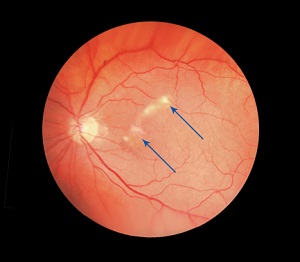
What is Epiretinal Membrane?
An epiretinal membrane also called a macular pucker, premacular fibrosis, surface wrinkling retinopathy or cellophane maculopathy is a thin film of fibrous tissue that forms over the macula (central part of the retina, the light receptive tissue at the back of the eye). The macula is responsible for sharp central vision required for reading, driving, etc. An epiretinal membrane causes blurred and distorted central vision.
As we grow older, the thick vitreous (a clear gel-like substance located between the crystalline lens and the retina) inside the eye begins to shrink and pull away from the retina. As the vitreous pulls away, small pieces of tissue or cells from the retina and other tissues in the eye are released into the vitreous gel that eventually settles on the macular. These cells start proliferating and form a thin sheet over the macular.
In most cases, an epiretinal membrane occurs in an eye with no history of eye problems. Occasionally, however, an epiretinal membrane can develop as a consequence of previous eye disorders such as detachment of the retina from its underlying layers of tissue, eye trauma, inflammatory disease, blood vessel abnormality or other conditions.
An epiretinal membrane is usually a mild eye condition with little or no effect on vision. However, sometimes, the epiretinal membrane grows slowly over time and causes wrinkles in the macular that leads to blurring or distortion (straight lines may appear wavy) in the central vision that may worsen. An epiretinal membrane does not cause complete blindness as it affects only central vision with peripheral vision remaining unaffected.
Diagnosis of Epiretinal Membrane
To diagnose an epiretinal membrane, the doctor will instill eye drops and dilate your pupils to view the retina. The degree of vision affected by an epiretinal membrane is assessed with an Amsler Grid (a grid of horizontal and vertical lines). A test called optical coherence tomography (OCT) is performed that uses a laser camera to capture pictures of the retina to record its anatomy, thickness, and wrinkles caused by the epiretinal membrane. Another test called fluorescein angiography may be considered occasionally.
Treatment for Epiretinal Membrane
Treatment is not required for a mild epiretinal membrane that has very little or no effect on vision. However, when vision declines, surgery is the only treatment option available.‘Vitrectomy‘ is the surgical procedure performed to remove the epiretinal membrane.
Related Topics
- Retinal Detachment
- Retinal Tear
- Diabetic Retinopathy
- Age-Related Macular Degeneration
- Retinal Vascular Diseases
- Retinal Artery Occlusion
- Retinal Vein Occlusion
- Retinal Hemorrhage
- Vitreous Hemorrhage of any Etiology
- Central Serous Retinopathy
- Posterior Vitreous Detachment
- Vitreomacular Traction Syndrome
- Epiretinal Membrane
- Macular Edema
- Macular Hole
- Retinoschisis
- Ocular Ischemic Syndrome
- Cystoid Macular edema
- Color Blindness
- Nyctalopia/Night Blindness
- Cone Dystrophy
- Choroideremia
- Retinopathy of Prematurity
- Uveitis & Ocular Inflammation
- Retinoblastoma

